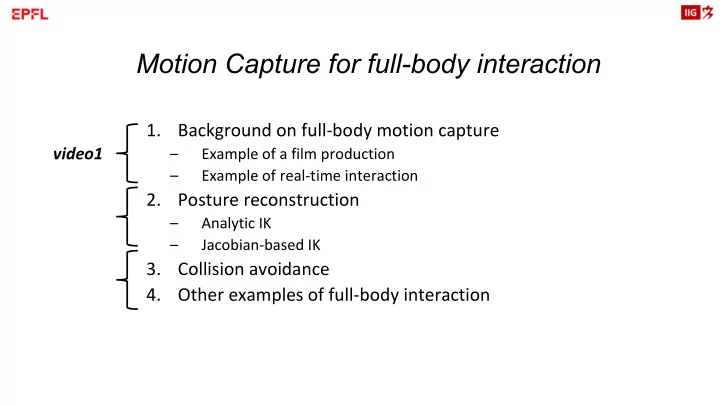

Motion Capture for full-body interaction 1. Background on full-body motion capture video1 – Example of a film production – Example of real-time interaction 2. Posture reconstruction – Analytic IK – Jacobian-based IK 3. Collision avoidance 4. Other examples of full-body interaction
1. Background on full-body motion capture Main motivation for using marker-based motion capture systems: precision Application fields (on-line and off-line): Entertainment: Visual effect/animation, theme park (e.g. Pharaoh tomb) Training and Simulation: Real-time mock-up, evaluation of stress Movement science: measuring 3D subject’s performance.
1. Background on full-body motion capture (2) • Motion Capture (mocap) – Lee Harrison: first “data suit” for TV production in 1967 : the posture is measured with exoskeleton and potentiometers [S 1998] – Still some exoskeleton on the market to measure posture [E2008] but rather invasive/cumbersome. Limited precision. Medialab Paris [S 1998] Scanimate system 1967
1. Background on full-body motion capture (3) • Occlusion-free technologies : • Magnetic sensors do not suffer from occlusion but from field distorsions due to metallic elements in the environment (e.g. Floor) • 6D sensor providing position & orientation • Datasuit with Inertial Measurement Units (IMU) : no occlusion but drift over time • Acceleration • Angular velocity • Magnetometer • to recover: • 3D position • 3D orientation Xsense MVN
1. Background on full-body motion capture (4) • Optical technologies : • Passive optical markers with IR cameras (VICON): • used both in film, game, VR, and orthopaedics. Precise but expensive. Weakness in real-time in case of occlusion: the system looses the markers IDs. IR Camera Suit with reflective markers Markers on feet, hands, head and torso [Artanim real- time Demo 2015]
Example of a film production (from Renaissance DVD) Simultaneous tracking of body posture and cloth movement Need of minimal and hollow decor elements (called props) to minimize occlusion
Example of a film production (from Renaissance DVD) Simultaneous body, head and eye direction (gaze) tracking Camera filming the reflexion of the eye in the glass with IR filter The eye direction can be expressed in the head Coordinate system [film «Renaissance»2006] IR light
Example in ergonomics and training in an industrial environment [ CLARTE ] The user is practicing a task in the CAVE (right) while an ergonomist evaluates the movement through an additional screen with a third person viewpoint .
1. Background on full-body motion capture (5) • Optical technologies • Active optical markers with IR camera (Phasespace), The system can recognize active markers even after occlusion LEDs Cameras Dimensions: 20 mm x 14 mm x 3.2 mm Weight: 4.5 grams Dimensions: 108 mm x 92 mm x 57 mm Each LED modulates at a unique frequency resulting in a unique Weight: 380 grams digital ID. LEDs are available in Red visible and Infra-red versions. Each camera achieves an Optical Resolution of 3600 x 3600 (12 Megapixel) using two linear detectors with 16-bit dynamic range. Onboard processors produce an impressive Subpixel Resolution of 30,000 x 30,000 at 480 Hz.
1. Background on full-body motion capture (6) • Low-cost active optical inside-out tracking technologies [Lighthouse] • Active emitters: 60hz IR pulses (HTC lighthouse technology using 1-2 base stations) • Numerous sensors embedded on a range of devices: HMD, controller, tracker • IMU is used in case of occlusion • IMU drift is reset at 60Hz • Delivers position and orientation provided enough sensors detect the IR signal from base station • Scalable with V2.0
Keys tasks of a real-time full-body mocap system: • Acquisition of the 3D location of the markers (or sensors) • Body posture reconstruction from the cloud of 3D points (or set of tracked devices) • High end: need to combine posture reconstruction with collision avoidance
[References] [S 1998] Sturman D., Computer Puppetry, IEEE CGA Jan-Fe 1998 [Clarte] https://www.clarte-lab.fr/projets/tous-nos-projets/8-ergo-wide [E2008] Exoskeleton gypsy: https://www.youtube.com/watch?v=S8mTd1GzLQw [Lighthouse] Adam Savage’s Tested videoblog interview of Alan Yates chief architect of Lighthouse system [Phasespace] http://phasespace.com/x2e-motion-capture/ Th8.12
Recommend
More recommend